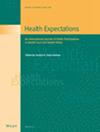The 11-item Patients' Perception of Safety Culture Scale (PaPSC) measures patients' perceptions of the safety culture within healthcare organizations. While patients can respond to these items, factors such as limited knowledge, unclear roles and insufficient information may influence their assessments. Despite previous research on the PaPSC, no qualitative validation has been conducted. This study addresses this gap by exploring patients' perspectives on safety culture.
A qualitative, exploratory approach was adopted, employing problem-centred interviews with patients from the cardiology and cardiothoracic surgery wards of a tertiary care university hospital. Thematic coding combining deductive and inductive methods was used to identify predefined and emergent themes.
Data saturation was reached after 22 interviews, providing a comprehensive account of patients' experiences. Most patients were able to respond to the PaPSC items, confirming its robustness in assessing safety culture. However, they emphasized interpersonal aspects such as empathy, trust and clear communication, and contextual elements such as the care environment and patient–staff interactions, which are less well represented in standardized instruments. Several items were perceived as ambiguous, highlighting the need for explanatory text to enhance clarity and response accuracy.
This study underscores the value of integrating qualitative methods with standardized tools such as the PaPSC to reveal nuanced aspects of safety culture. Active patient involvement in tool development can improve the comprehensiveness and effectiveness of safety interventions. Ensuring that safety culture assessments accurately reflect patients' experiences and needs contributes to more patient-centred healthcare practices.
Problem-centred interviews and the Think-Aloud method were used in this study to ensure active patient participation. Patients contributes by identifying areas where survey items needed further clarification or contextualization, thereby enhancing the validity and usability of the Patients' Perception of Safety Culture Scale (PaPSC). Their feedback also led to the refinements in the study design and tools, underscoring the importance of patient-centred approaches in healthcare safety research. Although patients were not directly involved in the study design, since the PaPSC scale items were predefined and derived from a prior critical review of existing instruments, their role in this validation study was crucial. The study aimed not to develop new items but to assess the applicability and clarity of an established instrument. The study empowered the patients to share their views openly in a supportive and respectful environment, offering valuable insights for improving safety culture assessment.



